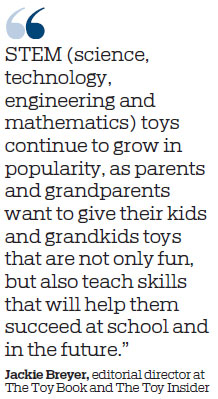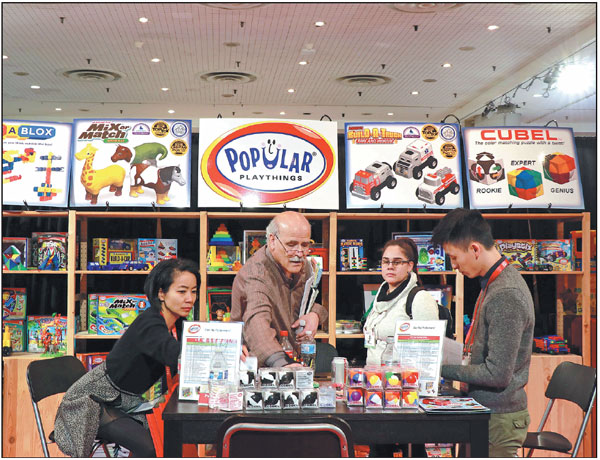Demand rising for educational toys
Parents are increasingly looking for products that encourage children to experiment and gain new learning experiences
Chinese companies, which provide most of the toys sold in the United States, are responding to industry demand to produce technologically advanced educational toys favored by parents.
"If we could make them (toys) in the US, we would," said Mark Pasin, director of international sales at Learning Resources & Educational Insights Inc. "But it (producing toys in China) is the best value and quality we can find - that's why people go to China."
Pasin's company, which he says relies heavily on China, is following this trend. Its Botley "The Coding Robot" won the Innovative Toy of the Year Award at the "Oscars of the toy industry", presented by the US Toy Association.
|
California-based educational toys company Popular Playthings exhibits its products at the 2019 North American International Toy Fair in New York on Feb 17. Zhang Ruinan / China Daily |
Rebecca Mond, vice-president of federal government affairs at the Toy Association, told China Daily that the infrastructure and capacity of the Chinese toy manufacturing industry make it crucial to US toy companies, even irreplaceable for some.
Data from the US Toy Association show that some 3 billion items - about 85 percent of the toys sold in the US - come from China.
Chinese companies were heavily represented at the 2019 North American International Toy Fair in New York, the largest annual toy show in the Western Hemisphere, which concluded on Feb 19 after four days. It attracted more than 1,000 exhibitors from 30 countries and regions along with some 7,000 registered buyers representing almost 3,000 retail outlets.
US companies are also following the trend and introducing toys that innovatively educate children and cultivate creativity.
Artie 3000, recognized as a leader in the category, is a robot that allows children to control its drawing path with drag-and-drop codes on a tablet.
"This is a great way to teach kids not only code, but also creativity - we want to encourage kids to learn to code" through art, said Lee Parkhurst, digital brand manager at Educational Insights, the developer of Artie 3000.
Artie is among STEM (science, technology, engineering and mathematics) and STEAM (science, technology, engineering, arts and mathematics) toys that are increasingly welcomed by today's parents.
The $21.6 billion US toy industry declined by 2 percent last year for the first time after four straight years of growth, with the closure of leading US toy retailer Toys 'R' Us being a factor.
The overall decline has not halted trends in several categories, including STEM and STEAM toys.
Parents are buying more STEM toys for their children to experiment with and gain learning experiences, allowing them to play with microscopes and learn about DNA, energy, motion, crystals, earth science, circuits, conductors, interactive pets, robotics and other complex topics, said Technavio, a market research firm, in its report Global Educational Toys Market 2017-2021.
Technavio's analysts also predicted that the STEM toys market will achieve a compound annual growth rate of nearly 5 percent by 2023.
A 2018 report by the Toy Association said that toys play a crucial role in teaching STEAM concepts to children by helping develop these necessary skills and competencies through play.
"At this age, play is the way kids learn - this is the way they enjoy (learning)," said Dinesh Advani, co-founder of Play Shifu, a company that specializes in educational toys and learning toys for kids.
"We are using technology to create learning experiences, gaming and fun experiences," he added.
A growing trend
An Artie 3000 costs six times more than the average toy in the US market, which costs about $10, according to the Toy Association.
An industry expert said parents would be more likely to spend that extra money on the educational or technological components featured in products like the Artie 3000.
"STEM toys continue to grow in popularity, as parents and grandparents want to give their kids and grandkids toys that are not only fun, but also teach skills that will help them succeed at school and in the future," Jackie Breyer, editorial director at The Toy Book and The Toy Insider, told China Daily by e-mail. "This trend has been building for a few years, and there is no sign of it slowing down."
"(Parents) understand in America we're making a big deal about STEM," Roberta Michnick Golinkoff, a professor of education, psychology, linguistics and cognitive science at the University of Delaware, told China Daily. "We're trying to increase the number of scientists and engineers in the US, and we're having trouble (doing it)."
"Our future really depends on the kind of innovation and discovery using STEM and STEAM - that needs to happen," said Golinkoff, who is also the author of the book Becoming Brilliant: What Science Tells Us About Raising Successful Children.

"So the toy companies also have picked up on that," she said.
"When you can code, then it means you know how to command a computer. In this day and age, and in the future, the computer is the most powerful tool," said Pooh Eamcharoenying, managing director of Project Lab Co Ltd, developer of another coding robot: Mojobot.
Using Mojobot, children can arrange various coding tags to control movements of a robot, which allows them to start coding naturally by playing.
"Coding is something that is big and challenging for a lot of kids. Some kids might be creative or more technical, but this allows them to combine those skills," Parkhurst said.
Values and priorities
Experts also said that big drivers of the trend are the values and priorities that young parents emphasize.
The educational aspects of the toys are what young parents especially love, they said.
"Young parents want what is best for their kids and understand the balance between educational toys, tech toys and classic play," Breyer said. "They want their kids to have advantages in the classroom while also maintaining their sense of creativity and wonder."
Toy producers are taking on comprehensive, cross-platform approaches while designing educational toys.
"Kids are really attracted to iPads and the sensorily rich media that comes with animation, sounds, graphics, all of those things," said Dinesh Advani, co-founder of Play Shifu.
The company focuses on products that combine augmented reality technology with tablets, bringing offline elements to tablet-based games.
Breyer agreed about the popularity of high-tech products with children, saying youngsters tend to follow their older siblings and parents, who are frequently seen using such products.
"At the same time, we don't want them to be away from the physical," Advani said.
Breyer said toy manufacturers will continue to offer an array of play patterns to satisfy the various ways children play and how their parents want them to grow and develop their minds.
"It's important for kids to have a well-balanced toy box. Kids are drawn to technology, YouTube, and app-based video games, and toy manufacturers are incorporating these features into toys to engage kids how and where they want to play," she said.
The presence of advanced technologies in toy designs will rise as those features become more affordable for toy manufacturers, she added.
Breyer said that while having tech-based skills is important for children as they grow up surrounded by technology, they also need time to play.
"When kids play with classic toys, they are learning important life skills, such as how to take turns, how to win (or lose) a game graciously, determination to build with construction toys, and how to use their sense of imagination and creativity to come up with new ideas and think in a more abstract way," she added.
Some experts say that for very young children, combining cutting-edge technology with toys might not be the best thing to do.
"You want them to understand how the world works before you present them with alternatives," said Golinkoff. "Play is best when it's active as opposed to passive, when it's engaging and not distracting, when it's meaningful and they can link what they're doing to their lives, and when it's socially interactive."
She said those are the four principles of learning that toymakers should be using to create successful products for children.
Contact the writers at zhangruinan@chinadailyusa.com
(China Daily 03/19/2019 page9)



















